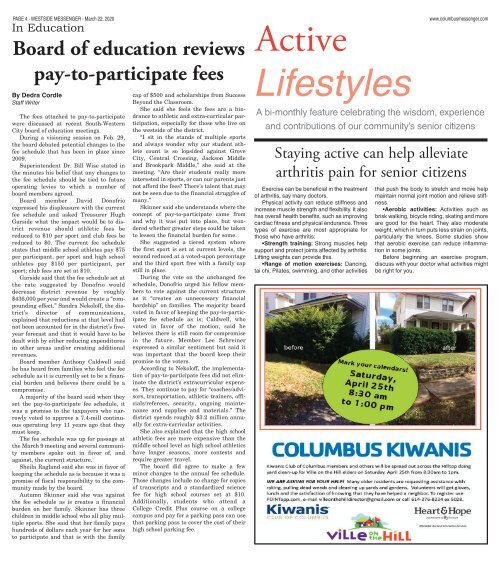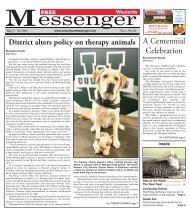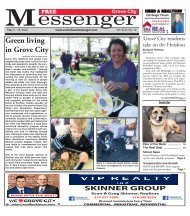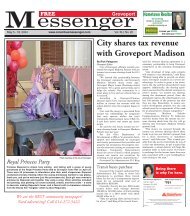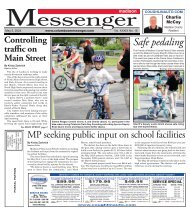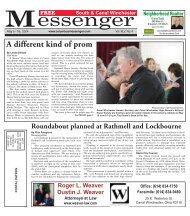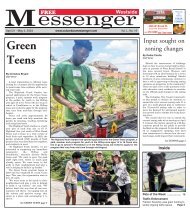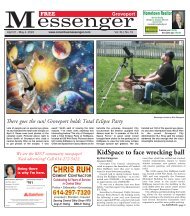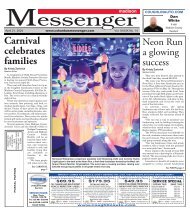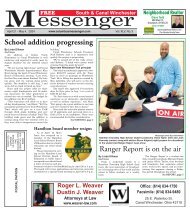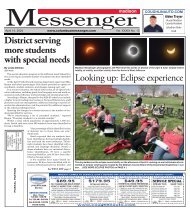Westside Messenger - March 22nd, 2020
You also want an ePaper? Increase the reach of your titles
YUMPU automatically turns print PDFs into web optimized ePapers that Google loves.
PAGE 4 - WESTSIDE MESSENGER - <strong>March</strong> 22, <strong>2020</strong><br />
In Education<br />
Board of education reviews<br />
pay-to-participate fees<br />
By Dedra Cordle<br />
Staff Writer<br />
The fees attached to pay-to-participate<br />
were discussed at recent South-Western<br />
City board of education meetings.<br />
During a visioning session on Feb. 29,<br />
the board debated potential changes to the<br />
fee schedule that has been in place since<br />
2009.<br />
Superintendent Dr. Bill Wise stated in<br />
the minutes his belief that any changes to<br />
the fee schedule should be tied to future<br />
operating levies to which a number of<br />
board members agreed.<br />
Board member David Donofrio<br />
expressed his displeasure with the current<br />
fee schedule and asked Treasurer Hugh<br />
Garside what the impact would be to district<br />
revenue should athletic fees be<br />
reduced to $10 per sport and club fees be<br />
reduced to $0. The current fee schedule<br />
states that middle school athletes pay $75<br />
per participant, per sport and high school<br />
athletes pay $150 per participant, per<br />
sport; club fees are set at $10.<br />
Garside said that the fee schedule set at<br />
the rate suggested by Donofrio would<br />
decrease district revenue by roughly<br />
$436,000 per year and would create a “compounding<br />
effect.” Sandra Nekoloff, the district’s<br />
director of communications,<br />
explained that reductions at that level had<br />
not been accounted for in the district’s fiveyear<br />
forecast and that it would have to be<br />
dealt with by either reducing expenditures<br />
in other areas and/or creating additional<br />
revenues.<br />
Board member Anthony Caldwell said<br />
he has heard from families who feel the fee<br />
schedule as it is currently set to be a financial<br />
burden and believes there could be a<br />
compromise.<br />
A majority of the board said when they<br />
set the pay-to-participate fee schedule, it<br />
was a promise to the taxpayers who narrowly<br />
voted to approve a 7.4-mill continuous<br />
operating levy 11 years ago that they<br />
must keep.<br />
The fee schedule was up for passage at<br />
the <strong>March</strong> 9 meeting and several community<br />
members spoke out in favor of, and<br />
against, the current structure.<br />
Sheila Ragland said she was in favor of<br />
keeping the schedule as is because it was a<br />
promise of fiscal responsibility to the community<br />
made by the board.<br />
Autumn Skinner said she was against<br />
the fee schedule as is creates a financial<br />
burden on her family. Skinner has three<br />
children in middle school who all play multiple<br />
sports. She said that her family pays<br />
hundreds of dollars each year for her sons<br />
to participate and that is with the family<br />
cap of $500 and scholarships from Success<br />
Beyond the Classroom.<br />
She said she feels the fees are a hindrance<br />
to athletic and extra-curricular participation,<br />
especially for those who live on<br />
the westside of the district.<br />
“I sit in the stands of multiple sports<br />
and always wonder why our student athlete<br />
count is so lopsided against Grove<br />
City, Central Crossing, Jackson Middle<br />
and Brookpark Middle,” she said at the<br />
meeting. “Are their students really more<br />
interested in sports, or can our parents just<br />
not afford the fees? There’s talent that may<br />
not be seen due to the financial struggles of<br />
many.”<br />
Skinner said she understands where the<br />
concept of pay-to-participate came from<br />
and why it was put into place, but wondered<br />
whether greater steps could be taken<br />
to lessen the financial burden for some.<br />
She suggested a tiered system where<br />
the first sport is set at current levels, the<br />
second reduced at a voted-upon percentage<br />
and the third sport free with a family cap<br />
still in place.<br />
During the vote on the unchanged fee<br />
schedule, Donofrio urged his fellow members<br />
to vote against the current structure<br />
as it “creates an unnecessary financial<br />
hardship” on families. The majority board<br />
voted in favor of keeping the pay-to-participate<br />
fee schedule as is; Caldwell, who<br />
voted in favor of the motion, said he<br />
believes there is still room for compromise<br />
in the future. Member Lee Schreiner<br />
expressed a similar sentiment but said it<br />
was important that the board keep their<br />
promise to the voters.<br />
According to Nekoloff, the implementation<br />
of pay-to-participate fees did not eliminate<br />
the district’s extracurricular expenses.<br />
They continue to pay for “coaches/advisors,<br />
transportation, athletic trainers, officials/referees,<br />
security, ongoing maintenance<br />
and supplies and materials.” The<br />
district spends roughly $3.2 million annually<br />
for extra-curricular activities.<br />
She also explained that the high school<br />
athletic fees are more expensive than the<br />
middle school level as high school athletics<br />
have longer seasons, more contests and<br />
require greater travel.<br />
The board did agree to make a few<br />
minor changes to the annual fee schedule.<br />
Those changes include no charge for copies<br />
of transcripts and a standardized science<br />
fee for high school courses set at $10.<br />
Additionally, students who attend a<br />
College Credit Plus course on a college<br />
campus and pay for a parking pass can use<br />
that parking pass to cover the cost of their<br />
high school parking fee.<br />
Active<br />
Lifestyles<br />
www.columbusmessenger.com<br />
A bi-monthly feature celebrating the wisdom, experience<br />
and contributions of our community’s senior citizens<br />
Staying active can help alleviate<br />
arthritis pain for senior citizens<br />
Exercise can be beneficial in the treatment<br />
of arthritis, say many doctors.<br />
Physical activity can reduce stiffness and<br />
increase muscle strength and flexibility. It also<br />
has overall health benefits, such as improving<br />
cardiac fitness and physical endurance. Three<br />
types of exercise are most appropriate for<br />
those who have arthritis:<br />
•Strength training: Strong muscles help<br />
support and protect joints affected by arthritis.<br />
Lifting weights can provide this.<br />
•Range of motion exercises: Dancing,<br />
tai chi, Pilates, swimming, and other activities<br />
that push the body to stretch and move help<br />
maintain normal joint motion and relieve stiffness.<br />
•Aerobic activities: Activities such as<br />
brisk walking, bicycle riding, skating and more<br />
are good for the heart. They also moderate<br />
weight, which in turn puts less strain on joints,<br />
particularly the knees. Some studies show<br />
that aerobic exercise can reduce inflammation<br />
in some joints.<br />
Before beginning an exercise program,<br />
discuss with your doctor what activities might<br />
be right for you.


